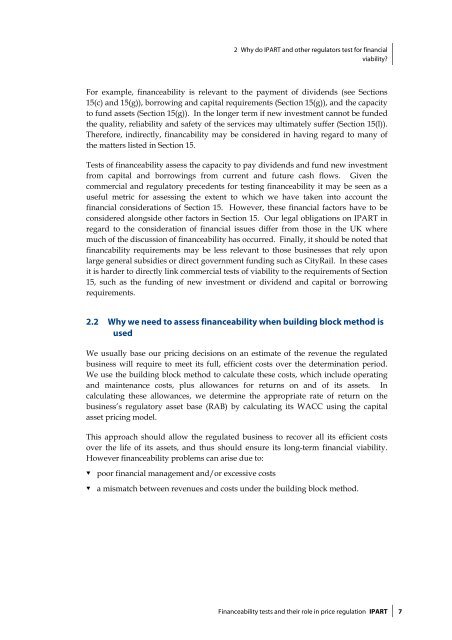Financeability tests and their role in price regulation - IPART - NSW ...
Financeability tests and their role in price regulation - IPART - NSW ...
Financeability tests and their role in price regulation - IPART - NSW ...
You also want an ePaper? Increase the reach of your titles
YUMPU automatically turns print PDFs into web optimized ePapers that Google loves.
2 Why do <strong>IPART</strong> <strong>and</strong> other regulators test for f<strong>in</strong>ancial<br />
viability?<br />
For example, f<strong>in</strong>anceability is relevant to the payment of dividends (see Sections<br />
15(c) <strong>and</strong> 15(g)), borrow<strong>in</strong>g <strong>and</strong> capital requirements (Section 15(g)), <strong>and</strong> the capacity<br />
to fund assets (Section 15(g)). In the longer term if new <strong>in</strong>vestment cannot be funded<br />
the quality, reliability <strong>and</strong> safety of the services may ultimately suffer (Section 15(l)).<br />
Therefore, <strong>in</strong>directly, f<strong>in</strong>ancability may be considered <strong>in</strong> hav<strong>in</strong>g regard to many of<br />
the matters listed <strong>in</strong> Section 15.<br />
Tests of f<strong>in</strong>anceability assess the capacity to pay dividends <strong>and</strong> fund new <strong>in</strong>vestment<br />
from capital <strong>and</strong> borrow<strong>in</strong>gs from current <strong>and</strong> future cash flows. Given the<br />
commercial <strong>and</strong> regulatory precedents for test<strong>in</strong>g f<strong>in</strong>anceability it may be seen as a<br />
useful metric for assess<strong>in</strong>g the extent to which we have taken <strong>in</strong>to account the<br />
f<strong>in</strong>ancial considerations of Section 15. However, these f<strong>in</strong>ancial factors have to be<br />
considered alongside other factors <strong>in</strong> Section 15. Our legal obligations on <strong>IPART</strong> <strong>in</strong><br />
regard to the consideration of f<strong>in</strong>ancial issues differ from those <strong>in</strong> the UK where<br />
much of the discussion of f<strong>in</strong>anceability has occurred. F<strong>in</strong>ally, it should be noted that<br />
f<strong>in</strong>ancability requirements may be less relevant to those bus<strong>in</strong>esses that rely upon<br />
large general subsidies or direct government fund<strong>in</strong>g such as CityRail. In these cases<br />
it is harder to directly l<strong>in</strong>k commercial <strong>tests</strong> of viability to the requirements of Section<br />
15, such as the fund<strong>in</strong>g of new <strong>in</strong>vestment or dividend <strong>and</strong> capital or borrow<strong>in</strong>g<br />
requirements.<br />
2.2 Why we need to assess f<strong>in</strong>anceability when build<strong>in</strong>g block method is<br />
used<br />
We usually base our pric<strong>in</strong>g decisions on an estimate of the revenue the regulated<br />
bus<strong>in</strong>ess will require to meet its full, efficient costs over the determ<strong>in</strong>ation period.<br />
We use the build<strong>in</strong>g block method to calculate these costs, which <strong>in</strong>clude operat<strong>in</strong>g<br />
<strong>and</strong> ma<strong>in</strong>tenance costs, plus allowances for returns on <strong>and</strong> of its assets. In<br />
calculat<strong>in</strong>g these allowances, we determ<strong>in</strong>e the appropriate rate of return on the<br />
bus<strong>in</strong>ess’s regulatory asset base (RAB) by calculat<strong>in</strong>g its WACC us<strong>in</strong>g the capital<br />
asset pric<strong>in</strong>g model.<br />
This approach should allow the regulated bus<strong>in</strong>ess to recover all its efficient costs<br />
over the life of its assets, <strong>and</strong> thus should ensure its long-term f<strong>in</strong>ancial viability.<br />
However f<strong>in</strong>anceability problems can arise due to:<br />
� poor f<strong>in</strong>ancial management <strong>and</strong>/or excessive costs<br />
� a mismatch between revenues <strong>and</strong> costs under the build<strong>in</strong>g block method.<br />
<strong>F<strong>in</strong>anceability</strong> <strong>tests</strong> <strong>and</strong> <strong>their</strong> <strong>role</strong> <strong>in</strong> <strong>price</strong> <strong>regulation</strong> <strong>IPART</strong> 7

















